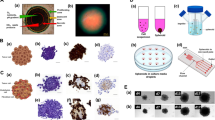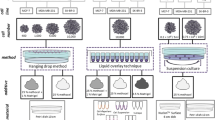Summary
The permanent epithelial cell-line EB 33 was developed from a human prostatic carcinoma. First attempts were made to characterize this strain by functional, morphological and kinetic parameters. The doubling time was found to be quite slow and to remain constant at 50.0 h during the exponential phase of growth over many passages. High acid phosphatase activity in the cytoplasma was found by histochemical means in comparison to HeLa cells. Electron microscopic studies suggested the epithelial origin of the cell-line. The karyotype was near triploid. Successful heterotransplantation into “nude mice” was achieved reproducibly. Histological examination of the heterotransplants revealed solid epithelial tumors with a rapid rate of growth. The findings reported suggest the prostatic epithelial origin of the cell-line EB 33. Their origin from the carcinomatous part of the explanted tissue remains still unproven. Future aspects for the development of an experimental model for human prostatic carcinoma are discussed.
Similar content being viewed by others
References
Buonassisi, V., Sato, G., Cohen, A. I.: Hormone-producing cultures of adrenal and pituitary tumor origin. Proc. nat. Acad. Sci. (Wash.) 48, 1184–1190 (1962)
Flanagan, S. P.: “Nude”, a new hairless gene with pleiotrophic effects in the mouse. Genet. Res. 8, 295–309 (1966)
Furuyama, J.: Methods of chromosomal analysis. J. clin. Sci. (Osaka) 6, 656–664 (1970)
Lieberman, I., Ove, P.: Enzyme activity levels in mammalian cell cultures. J. Biol. Chem. 233, 634–640 (1958)
Pantelouris, E. M.: Absence of thymus in a mouse mutant. Nature 217, 370–371 (1968)
Puck, T., Kao, F.: Genetics of somatic mammalian cells, VII. Induction and isolation of nutritional mutants in Chinese hamster cells. Proc. nat. Acad. Sci. (Wash.) 60, 1275–1281 (1968)
Schroeder, F. H., Sato, G., Gittes, R. H.: Human prostatic adenocarcinoma: Growth in monolayer tissue culture. J. Urol. 106, 734–739 (1971)
Schroeder, F. H., Mackensen, S. J.: Human prostatic adenoma and carcinoma in cell culture: The effects of androgen-free culture medium. Invest. Urology (accepted for publication)
Sato, G., Zaroff, L., Millis, S. E.: Tissue culture populations and their relation to the tissue of origin. Proc. nat. Acad. Sci. (Wash.) 46, 963–972 (1960)
Sato, G. H., Yasumara, Y.: Retention of differentiated function in dispersed cell culture. Trans. N. Y. Acad. Sci. 28, 1063–1079 (1966)
Sato, G., Augusti-Tocco, G., Posner, M.: Hormone-secreting and hormone-responsive cell cultures. In: Recent Progress in Hormone Research, Vol. 26 p. 539–545, New York 1970
Sigma Technical Bulletin No. 85. The histochemical demonstration of acid and alkaline phosphatase. St. Louis 1969
Stonington, O. G., Hemmingsen, H.: Culture of cells as a monolayer derived from the epithelium of the human prostate: A new cell growth technique. J. Urol. 106, 393–400 (1971)
Vincent, M.: Strain MA 160, Catalogue of Microbiological Assoc., Bethesda, Md., USA
Author information
Authors and Affiliations
Additional information
This work is supported by the Deutsche Forschungsgemeinschaft, Grants Nr. Schr 113/1-7.
Rights and permissions
About this article
Cite this article
Okada, K., Schröder, F.H. Human prostatic carcinoma in cell culture: Preliminary report on the development and characterization of an epithelial cell line (EB 33). Urol. Res. 2, 111–121 (1974). https://doi.org/10.1007/BF00254727
Received:
Issue Date:
DOI: https://doi.org/10.1007/BF00254727




